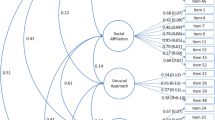Abstract
Theory of mind skills and a range of social behaviour in everyday life were assessed in a sample of 21 children with pervasive developmental disorders and 22 normally-developing preschoolers. Parents, teachers and therapists were interviewed using the Vineland Adaptive using the Vineland Adaptive Behaviour Scales (18) and a new supplementary scale, the “Eckelle d'Adaptation Sociale pour Enfants” (EASE). Teachers and therapists were able to differentiate subtle forms of social problems in everyday life between subgroups of children d diagnosed later to have either autism (n=13) or PDDNOS (n=8), according to DSM-III-R (1) criteria. This study offers a (small) cross-cultural replication of recent work suggesting that differences in the mentalising skills of children with autism are reflected in the everyday social behaviour of this group. A significant effect of informant was found for the PDD group, and this effect was particularly pronounced when children with autism were considered separately. The implications of informant differences are discussed.
Similar content being viewed by others
References
American Psychiatric Association (1987) Diagnostic & Statistical Manual of Mental Disorders. Third Edition - Revised Washington, DC: American Psychiatric Association
Baron-Cohen S, Leslie A, Frith U (1985) Does the autistic child have a “theory of mind”"? Cognition 21: 37–46
Centre de Psychologie Appliquee (1974) Echelle d'intelligence de Weschler pour la période préscolaire et primaire. Editions du Centre de Psychologie Appliquee. Paris: Centre de Psychologie Appliquee
Centre de Psychologie Appliquee (1981) Echelle d'intelligence de Weschler pour enfants — forme revisé e. Editions du Centre de Psychologie Appliquee. Paris: Centre de Psychologie Appliquee
Fombonne E, Achard S (1993) The Vineland Adaptive Behaviour Scale in a sample of normal French children: A research note. Journal of Child Psychology and Psychiatry 34:1051–1058
Fombonne E, Siddons F, Achard S, Frith U, Happé (1994) Adaptive behaviour and theory of mind in autism. European Child and Adolescent Psychiatry 3:176–186
Frith U, Happé F, Siddons F (1994) Autism and theory of mind in everyday life. Social Development 3:108–124
Konstantareas MM, Homatidis S (1989) Assessing child symptom severity and stress in parents of autistic children. Journal of Child Psychology and Psychiatry and Allied Disciplines 30:459–470
Loeber R, Green SM, Lahey BB, Stouthamer-Loeber M (1991) Differences and similarities between children, mothers, and teachers as informants on disruptive child behaviour. Journal of Abnormal Child Psychology 19:75–95
Loveland KA, Kelley ML (1988) Development of adaptive behaviour in adolescents and young adults with autism and Down syndrome. American Journal of Mental Retardation 96:13–20
Mayes L, Volkmar F, Hooks M, Cicchetti (1993) Differentiating pervasive developmental disorder not otherwise specified from autism and language disorders. Journal of Autism & Developmental Disorders 23:79–70
Miller SA, Davis TL (1992) Beliefs about children: A comparative study of mothers, teachers, peers and self. Child Development 63:1251–1265
Misës R, Fortineau J, Jeammet P, Lang JL, Mazet P, Plantade A, Quemada N (1988) Classification Française des troubles mentaux de l'enfant et de l'adolescent. La psychiatrie de l'enfant 31:67–134
Oswald DP, Ollendick (1989) Role-taking and social competence in autism and mental retardation. Journal of Autism & Developmental Disorders 19:119–128
Perner J, Leekam SR, Wimmer H (1987) Three year old's difficulty with false-belief: the case for a conceptual deficit. British Journal of Developmental Psychology 5:125–37
Schopler E, Reichler RJ (1979) Individualised assessment and for autistic and developmentally delayed children. Volume 1, psychoeducational profile. Baltimore: University Park Press
Schopler E, Reichler R, Renner B (1988) The Childhood Autism Rating Scale (CARS) Los Angeles, CA: Western Psychological
Sparrow S, Balla D, Cicchetti D (1984) Vineland Adaptive Behaviour Scale (Survey Form) Circle Pines, Minnesota: American Guidance Survey
Stone WL, Rosenbaum JL (1988) A comparison of teacher and parent views of Autism. Journal of Autism and Developmental Disorders 18:403–414
Szatmari P, Archer L, Fisman S, Streiner DL (1994) Parent and teacher agreement in the assessment of Pervasive Developmental Disorders. Journal of Autism and Developmental Disorders 24:703–717
Author information
Authors and Affiliations
Rights and permissions
About this article
Cite this article
Hughes, C., Soares-Boucaud, I., Hochmann, J. et al. Social behaviour in pervasive developmental disorders: Effects of informant, group and “theory-of-mind”. European Child & Adolescent Psychiatry 6, 191–198 (1997). https://doi.org/10.1007/BF00539925
Received:
Accepted:
Issue Date:
DOI: https://doi.org/10.1007/BF00539925




